Electricity and heat production and fuels 2012
Production of electricity falling, consumption rising
Total electricity consumption grew by one per cent from the previous year and amounted to 85.1 terawatt hours (TWh), or one billion kilowatt hours (kWh). Eighty per cent of the consumption was covered with domestic production and twenty per cent with net imports of electricity, which means the difference of imports and exports. Electricity is imported to Finland from the Nordic countries, Russia and Estonia. Electricity is also exported from Finland to other Nordic countries and Estonia. Net imports of electricity grew by 26 per cent from the previous year.
Imports from Sweden grew over 2.5 times as high, since inexpensive hydro electricity was well available. The good Nordic water situation that started in summer 2011 continued throughout 2012. Large exports of electricity to Sweden in the last few years halted almost entirely in 2012. Imports from Russia went down by 59 per cent. The decrease was mainly due to the increase in imports of Swedish electricity, but also due to price rises of Russian electricity, because Russia has included a capacity charge in the price of its export electricity. For the first time, more electricity was exported to Estonia in 2012 than imported from there to Finland.
Figure 1. Production of electricity, district heat and industrial heat in 2000–2012
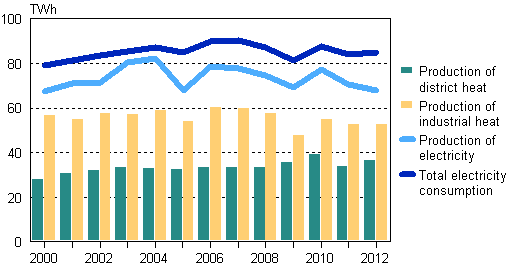
As in the previous year, the cool winter in the early part of the year kept the consumption of electricity at the previous year's level but the falling trends of manufacturing lowered the need for electricity. Autumn 2012 was in turn cooler than the previous autumn, which increased consumption of electricity. Manufacturing also used more electricity in autumn 2012 than in autumn 2011. According to Statistics Finland's Volume Index of Industrial Output, total industrial output in Finland went down by over two per cent in 2012. In electricity-intensive manufacturing, preliminary year-on-year changes of the forest and metal industries were falling. For the chemical industry, the year-on-year change in the index in turn showed growth from the previous year.
The production of electricity in Finland amounted to 67.7 TWh in 2012. The production decreased by four per cent from the previous year. Separate production of electricity with condensing power decreased by 47 per cent. The volume of the production of condensing electricity fluctuates according to the demand for electricity and the availability of hydro power in the Nordic countries. Electricity generated with combined heat and power production decreased by nine per cent. The amount of electricity produced with nuclear power remained quite constant at around 22 TWh. Nuclear power accounted for 33 per cent of the electricity produced in Finland in 2012. Nearly as much electricity was produced with hydro power as in the record year of 2008. From the previous year, the growth was 36 per cent and the share of hydro power in electricity production rose to 25 per cent. The share of wind power in produced electricity remained at under one per cent.
The amount of electricity produced with fossil fuels decreased by nearly one-third, and its share of electricity production went down to 21 per cent. The biggest fossil fuels are coal and natural gas, as ten per cent of electricity was produced with both. Electricity produced with peat accounted for five per cent of electricity production. Forty-one per cent of the electricity produced in Finland was produced with renewable energy sources. Sixty per cent of this was produced with hydro power and almost all of the remainder with wood. Wood, or wood-based fuels comprise wood fuels, so-called black liquor from the forest industry that originates from the processes of the pulp industry, and other wood-based fuels such as by-products and waste products from the wood processing industry (e.g. paper, pine oil, methanol and turpentine, fibrous sludges and odour gases). Over seven per cent of electricity was produced with both black liquor and other wood fuels, i.e. 15 per cent in all.
Figure 2. Electricity production by energy source 2012
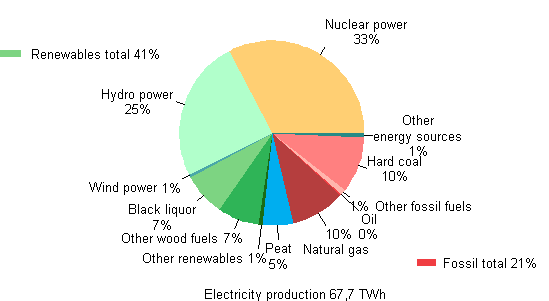
Chillier autumn than in the previous year increased the need for district heat
The production of district heat totalled 36.7 TWh in 2012. The production went down by eight per cent from the previous year. The heating energy need of buildings was at a high level due to the cold winter in the early part of the year and the cool December. In 2012, the consumption of district heat rose compared with the previous year, because autumn 2012 was cooler than the previous one. According to the Finnish Meteorological Institute, after the exceptionally mild autumn 2011, autumn 2012 was typical. In 2010, the demand for district heat was record high, for the autumn, as well as the winter, was also cold.
Fifty-five per cent of district heat was produced with fossil fuels. One-half of this was produced with natural gas and nearly all the rest with coal. District heat produced with peat accounted for 17 per cent of total production. The share of district heat produced with renewable fuels rose to 26 per cent. Production of district heat grew particularly with wood fuels.
Figure 3. District heat production 2000–2012
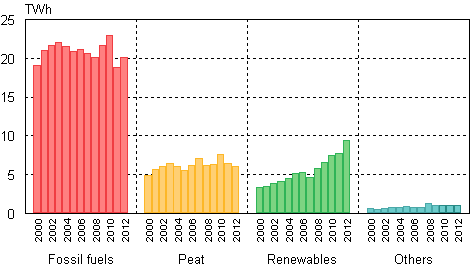
Figure 4. Heat production 2000–2012
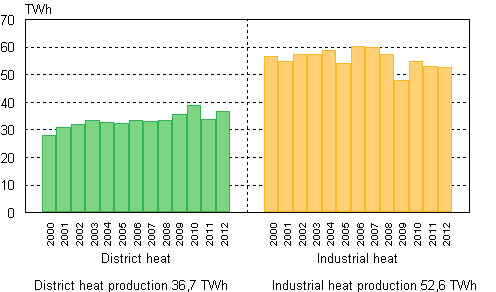
Manufacturing trends kept the need for industrial heat low
The production of industrial heat was 52.6 TWh in 2012. The production fell only a little from the previous year (-0.4%), although the downturn in manufacturing continued. As in the previous years, the use of industrial heat remained at a low level.
Sixty-eight per cent of the heat used by industry was produced with renewable fuels. Fossil fuels produced 19 per cent and peat seven per cent of industrial heat. The main fossil fuel in the production of industrial heat was natural gas, which accounted for 12 per cent of the total. In 2012, 46 per cent of industrial heat production was covered with black liquor from the forest industry and 21 per cent with other wood fuels.
According to Statistics Finland's Volume Index of Industrial Output, total industrial output in Finland went down by over two per cent in 2012. In heat-intensive manufacturing, preliminary year-on-year changes of the forest and metal industries were falling. For the chemical industry, the year-on-year change in the index in turn showed growth from the previous year.
Figure 5. Industrial heat production 2000–2012
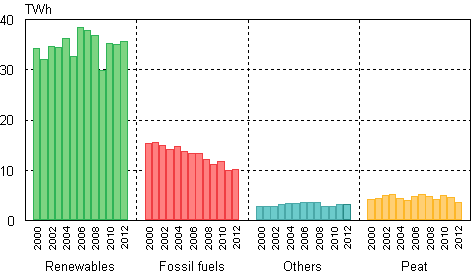
Nearly one-half of used fuels renewable
The use of fuels in the production of electricity and heat decreased by eight per cent in 2012. In fuel use, renewable fuels were already close to one-half: they made up 47 per cent of fuel use. The use of fossil fuels covered 38 per cent and peat 11 per cent. The remaining four per cent was derived from the so-called other energy sources, which include hydrogen, sulphur and exothermic heat from industry that is derived from the chemical industry. The use of renewable fuels increased by only two per cent from the previous year but the use of fossil fuels decreased by 14 per cent and the use of peat by 24 per cent.
This examination of fuels excludes so-called non-fuel modes of energy production, i.e. hydro and wind power. Nuclear power is also not regarded as equal with fuels in this examination. According to the international statistical convention, the efficiency ratio of nuclear power is assumes to be 33 per cent, i.e. three-fold amount compared to the produced electricity is counted as primary energy.
Black liquor from the forest industry remained the biggest fuel. The use of black liquor grew slightly, although according to the Volume Index of Industrial Output, the moving year-on-year change in the forest industry's output was -2.5 per cent. The uses of peat, coal and natural gas decreased considerably. The uses of wood fuels and municipal waste grew. Municipal waste and recycled waste produced from waste are counted in so-called mixed fuels that are divided into renewable and fossil fuels by the biofuel share included in them. The default shares according to Statistics Finland's fuel classification are used in the calculation. In these statistics, these fuels are found from the sets of fuels called other renewable and other fossil fuels. As the name indicates, the categories also include other fuels, such as biogas, plastic waste and coke. Other energy sources in turn contain such as hydrogen, sulphur and exothermic heat from industry, which is mainly derived from an exothermic reaction in the chemical industry, i.e. a heat-transferring chemical reaction.
Figure 6. Use of fuels in electricity and heat production 2011–2012
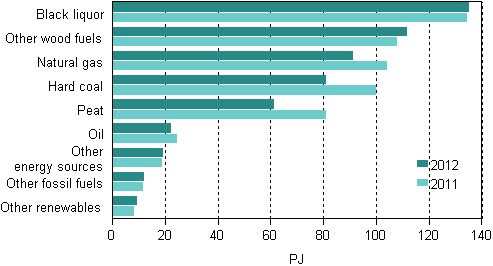
The use of fuels in separate production of electricity means the use of fuels in the production of condensing power. Other separate production of electricity, i.e. nuclear, hydro and wind power, is regarded as being so-called non-fuel. The amount of produced condensing power decreased by 47 per cent and the volume of fuel used for condensing power decreased by 45 per cent. The difference is explained by the efficiency ratio of production, i.e. the ratio between produced electricity and used amount of fuel.
The efficiency ratio of condensing power typically varies from 35 to 45 per cent, while around 75 to 85 per cent of fuel energy can be utilised in combined heat and power production and some 80 to 90 per cent in separate heat production.
Nearly 60 per cent of the fuels used in condensing power production were fossil fuels. In turn, the use of peat amounted to 13 per cent. Coal was the most important fossil fuel, although its use diminished by 49 per cent. The use of peat fell by 64 per cent and that of renewable fuels by 34 per cent. As the use of fossil fuels and peat and the entire fuel use diminished, the share of renewable fuels rose to 25 per cent.
Figure 7. Use of fuels in separate electricity production 2011–2012
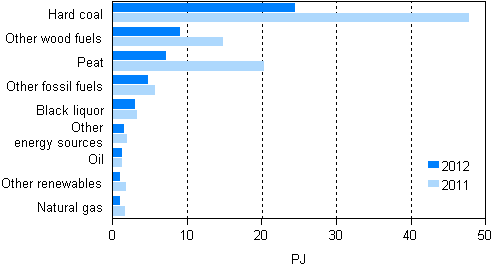
In fuels in combined heat and power production, the uses of fossil fuels and peat both went down by ten per cent. The use of renewable fuels went up by six per cent. The major changes were the decrease in the use of natural gas and oil and the growth in the use of other wood fuels and municipal waste. Municipal waste and recycled waste produced from waste are counted in so-called mixed fuels that are divided into renewable and fossil fuels by the biofuel share included in them. The default shares according to Statistics Finland's fuel classification are used in the calculation. In these statistics, these fuels are found from the sets of fuels called other renewables and other fossil fuels. As the name indicates, the categories also include other fuels, such as biogas, plastic waste and coke.
As the use of fossil fuels and peat diminished, the share of renewable fuels rose to over 50 per cent (54%). Black liquor from the forest industry remained the most significant fuel, although the trends of the forest industry went down.
Figure 8. Use of fuels in combined heat and power production 2011–2012
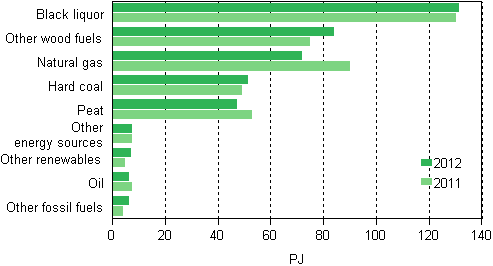
The use of coal in separate heat production grew by 87 per cent. However, the use volume is still fairly small and covers just seven per cent of the total. The use of natural gas went up by 51 per cent. Other wood fuels stayed the biggest fuel category and covered one-quarter of the use. Oil was still used most in 2010, but now its share has fallen to one fifth. Fossil fuels made up 52 per cent of the total, while the share of renewable fuels was 27 per cent.
Figure 9. Use of fuels in separate heat production 2011–2012
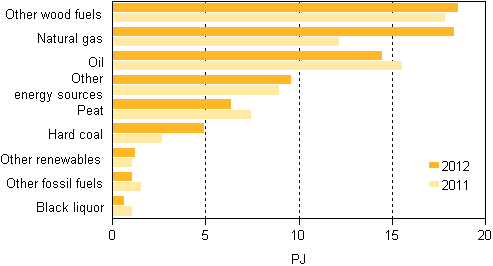
Source: Statistics on production of electricity and heat, Statistics Finland and Electricity statistics, Finnish Energy Industries
Inquiries: Minna Niininen 09 1734 3549, energia@stat.fi
Director in charge: Leena Storgårds
Updated 5.11.2013
Official Statistics of Finland (OSF):
Production of electricity and heat [e-publication].
ISSN=1798-5099. 2012,
Electricity and heat production and fuels 2012
. Helsinki: Statistics Finland [referred: 19.4.2024].
Access method: http://www.stat.fi/til/salatuo/2012/salatuo_2012_2013-11-05_kat_001_en.html

